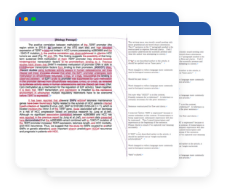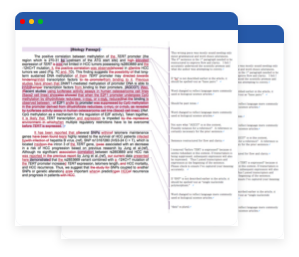如何在英文写作里正确使用逗号(,)
逗号是英文写作技法里的一个关键。它可以被用来划分句子的不同部分。在恰当的时机里正确使用逗号,能使你的文字清晰易懂,能避免歧义,读起来自然流畅。
遗憾的是,许多人在写作时常常忽略逗号的正确用法。这篇简单易解的指南,将会为您介绍英文里的逗号,包括各类使用情形以及正确的使用方法。
目录
- 1.用逗号连子句
- 2.逗号在主语、动词与宾语里的使用规则
- 3.限定性定语从句与非限定性定语从句
- 4.使用逗号划分主从句
- 5.牛津逗号
- 6.e.g. 与 i.e.
英文逗号的几个基本用法
| 不正确 | 正确 | |
|---|---|---|
| 在复合句中,在连词或连接词(and, but , or, for, so, nor, yet)前可以使用逗号。 |
The apple is red the orange is green. |
The apple is red, and the orange is green. |
| 在非限定性定语从句的前后,需要使用逗号将其与主句分隔开。 |
The apple which is red is for the teacher. |
The apple, which is red, is for the teacher. |
| 当句子里有状语从句(包括介词短语、分词短语等)时,逗号通常放于从句之后,主语之前或置于句子中间。 |
In the afternoon we are going to pick apples. |
In the afternoon, we are going to pick apples. |
| 使用逗号来分隔句子中具有相同功能的一系列单词或短语。 |
He likes apples oranges and pears. |
He likes apples, oranges, and pears. |
使用逗号连接子句
连接子句是逗号的主要功能之一。逗号不仅能使句子读起来自然流畅,帮助读者看清句子结构,厘清句子成分。
独立子句( independent clauses) vs. 从属子句(dependent clauses)
独立子句(independent clauses)由主语和动词构成,表达了一个完整的意思,可以被单独作为句子。请看以下例句。
- The apple is red.
- Apples grow on trees.
- Susan has picked an apple.
而从属子句(dependent clauses),虽然包含一对主语和动词,但其不能单独存在,需要加上独立子句才能表达完整句义。
- when it is ripe
- although not all fruits grow on trees
- because it looked delicious
从属标记词的作用是把一个独立子句变成从属子句。
- It is ripe. → when it is ripe
- Not all fruits grow on trees. → although not all fruits grow on trees
- It looked delicious. → because it looked delicious
常用的从属标记词 : because, despite, if, before, although, though, before, after, since, as, unless, until, when, whenever, whether, while
连写句/连续句(run-on sentences)与逗号拼接(comma splice)
连写句(run-on sentences)是两个或更多的独立子句(即"完整的句子")连接起来而没有放置适当的标点符号或连词的句子。分开或连接两个独立句有三种不同的方式。
-
用一个句号
由于独立子句是完整的句子,因此你可以用一个句号分开两个独立子句。
- 子句 1
- The apple is red.
- 子句 2
- It is for the teacher.
- 合并
- The apple is red. It is for the teacher.
-
用分号(或冒号——决定于子句的关联方式)
分号可以用来连接两个密切相关的独立子句。
- 子句 1
- Susan likes reading.
- 子句 2
- She has been reading since she was two.
- 合并
- Susan likes reading; she has been reading since she was two.
冒号的用法也类似,但两个子句的内容要紧密相关,而且第二个子句要定义第一 个子句。
- 子句 1
- The orange was a favorite of Portuguese sailors.
- 子句 2
- The fruit is high in vitamin C, which is effective for preventing scurvy.
- 合并
- The orange was a favorite of Portuguese sailors: the fruit is high in vitamin C, which is effective for preventing scurvy.
-
使用带有逗号的协调连词配合。
逗号可以和连接词合并使用。使用的要点是需要选择一个适合上下文语境的连词。
常用的连词: and, or, but, so, yet, for
- 子句 1
- Apples grow on trees.
- 子句 2
- Not all fruits grow on trees.
- 合并
- Apples grow on trees, but not all fruits grow on trees.
连接两个独立子句有三种不正确的方式:
-
不使用标点符号
连接两个独立子句最明显的不正确方法,就是不用标点符号或连接词就把它们放在一起。
- Incorrect
- Apples grow on trees not all fruits grow on trees.
-
只用一个逗号
逗号本身不足以正确地连接两个独立子句。这种错误称为逗号拼接(comma splice)。
- Incorrect
- Apples grow on trees, not all fruits grow on trees.
-
只用一个连接词
单独使用一个连接词,不足以正确地连接两个独立子句。
- Incorrect
- Apples grow on trees but not all fruits grow on trees.
合并独立子句也可以用其他的标点符号,例如:句号或分号,或使用一个跟随着连接词的逗号。
- Correct
- Apples grow on trees. Not all fruits grow on trees.
- Correct
- Apples grow on trees, but not all fruits grow on trees.
逗号在主语、动词与宾语里的使用规则
逗号不能随便插入句子的任何一个位置。请注意,逗号(1)不可用来分开主语和动词,(2)不可用来分开动词和宾语。
切勿:用逗号将主语和动词分开
许多作者认为逗号应该放在说话者语气停顿的地方。在英语的口语中,人们偶尔会在主语和动词之间停顿。然而,在英语写作中,在主语和动词之间加逗号会打断句子的自然流畅。
- Incorrect
- Susan’s roommate Rosa, planted an apple tree.
- Correct
- Susan’s roommate Rosa planted an apple tree.
切勿:用逗号把动词和宾语分开
逗号不应该把及物动词(transitive verb)和直接宾语(direct object)分开。就像上面的情况一样,这是另一个很难凭着直觉发现的错误。把动词和宾语分开会影响句子的可读性,并使句子显得不自然。
- Incorrect
- Susan said, her roommate planted a tree.
- Correct
- Susan said her roommate planted a tree.
限定性定语从句和非限定性定语从句
正确使用逗号的关键,在于了解不同子句类型之间的区别。其中最重要的要学会区别独立子句和从属子句,这点我们在上文已提及,除此之外就是要学会区别限定性定语从句和非限从句。
限定性定语从句 vs, 非限定性定语从句——有什么差别?
限定性定语从句用于对先行词的意义进行修饰、限制和识别,如果去掉,就会造成句意不完整或概念不清;而非限定性定语从句用于对先行词起补充说明作用,如果省略,句意仍然清楚、完整。
- Example
-
The essay that Jane wrote is five pages long.
“that Jane wrote” 是一个限定性定语从句,因为没有它,我们就不清楚有五页长的散文是哪一篇。是珍写了这篇散文,而不是别人写的这个事实,是个不可省略的重要信息。
- Example
-
Jane’s essay, which is five pages long, got an A.
“which is five pages long” 是一个非限定性定语从句。这句话的重点是想表达珍写的散文得到了 A。而那篇散文的长度有5页只是一个补充信息,可有可无。
切勿:使用逗号隔开限定性定语从句
限定性定语从句不可以使用逗号分开。
- (a)
- The girl who sits in the front asks a lot of questions.
- (b)
- The girl, who sits in the front, asks a lot of questions.
哪一个句子是正确的?(a)还是(b)?首先,必须辨识 “who sits in the front” 这个成分是限定性定语从句还是非限定性定语从句。很显然,如果沒有 “who sits in the front” 这个句子,我们就不清楚问了很多问题的是哪一个女孩。因此, “who sits in the front” 是一个限定性定语从句。正确的句子是(a)。
切记:要使用逗号隔开非限定性定语从句
非限定性定语从句应该用逗号分开。
- (a)
- My friend Amy who sits in the front asks a lot of questions.
- (b)
- My friend Amy, who sits in the front, asks a lot of questions.
哪一个句子是正确的?(a)还是(b)?同样地,我们需要先辨识 “who sits in the front” 是限定性定语从句还是非限定性定语从句。这个句子重点想表达的是“艾米问了很多问题。” 而她坐在前面的事实只是一个可有可无的补充信息。因此, “who sits in the front” 是一个非限定性定语从句。正确的句子是(b)。
使用逗号划分主从句
用逗号划分主从句,可以使句子结构更加清晰明白,我们看下面两个例句 :
- (a)
- After eating lunch with his friends, Peter went to the library.
- (b)
- After eating lunch with his friends Peter went to the library.
比较一下(a)与(b),可以显然发现(a)的可读性较高。如果把介绍性—“after eating lunch with his friends”—后面的逗号拿掉,我们就很难一眼就看出这个句子的主语就是「彼得」。
牛津逗号(Oxford Comma)
一般来说,牛津逗号(oxford comma),又称哈佛逗号(Harvard comma)、序列逗号(serial comma),指的是在英语中列举多个对象时,在最后的“和(and)”前也加上一个逗号,以减少可能的歧义。使用还是不使用,在英文写作里是个人的选择(当然在同一篇文章里应要确保牛津逗号的使用与否前后一致)。牛津逗号在美式英语里被认为是标准用法,也是存在于某些写作风格里的一个强制性准则。但是,为了避免歧义发生,在某些情况是必须使用牛津逗号的。
- Example
- Lana wrote letters to her parents, Leia and Michael.
这个句子可做两种诠释:(1)莱雅和麦克是她父母的名字,或(2)拉娜写信给她的父母和另外两个叫莱雅和麦克的人。但是若在莱雅后面加一个逗号,就可以清楚地表示莱雅和麦克是另外两个人,而不是拉娜父母的名字。
e.g. 与 i.e
在 e.g. 和 i.e. 后面使用逗号的规则,因写作风格的不同而异。然而,标准的美式英语,始终都要在 e.g. 和 i.e. 后面加一个逗号。
- Incorrect
- There are many tropical fruits, e.g. mangos, coconuts, and bananas.
- Correct
- There are many tropical fruits, e.g., mangos, coconuts, and bananas.
小贴士: 逗号虽小,却对句子的清晰度和可读性至关重要。如果你对逗号的使用规则感到不确定,可以借助语法检查软件来辅助校对。这些工具能自动检测逗号的遗漏、多余或错误使用(比如在并列形容词或非限制性从句中的逗号问题),帮助你更高效地优化写作。当然,工具不能完全替代语法知识,但结合规则学习和智能检查,能让你的英文写作更加精准、流畅。






